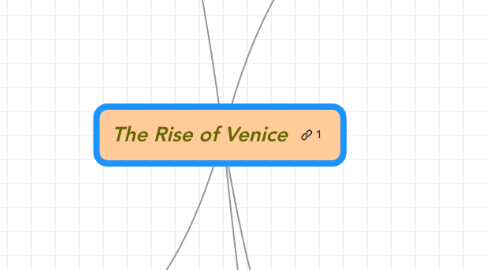
1. Leadership
1.1. Establishing Control in the Adriatic Sea
1.1.1. Maintaining a peaceful atmosphere in the region enabled commercial prosperity.
1.1.1.1. Warring cities were reconciled.
1.1.1.2. Treaties were signed between major powers in order to sustain harmonious relations.
1.1.1.3. Piracy was subjugated to protect the cargo of traders and merchants.
1.2. Building the Venetian Empire
1.2.1. Foreign territories were conquered to seal Venice's status as an empire.
1.2.1.1. Military campaigns, such as the Fourth Crusade, initiated Venice's takeover of Constantinople from the Byzantium Empire.
1.2.1.2. This event signalled the waning of the latter, which would hasten the former's rise.
1.3. Expanding the Venetian Empire in the Mediterranean Sea
1.3.1. Venice progressed as a naval power.
1.3.2. Military outposts were set up to protect vital trade routes.
2. Trade Developments and Expansion
2.1. Attitude towards Trade
2.1.1. Rising above the Competition
2.1.1.1. Were able to negotiate lower tax rates than their competitors.
2.1.1.2. Imported rare and valued spices from the East.
2.1.2. Enterprising Spirit
2.1.2.1. Explored new commercial routes, stocks and economies by venturing to obscure destinations.
2.1.2.2. Polo family and their journey to the East bolstered relations between Venice and the countries there, resulting in trade expansion.
2.2. Innovations in Maritime Technology
2.2.1. Advancements in equipment allowed for travelling in all the seasons year round, solving hindrances such as poor visibility in bad weather.
2.2.2. Shipwrights designed superior vessels and galleys, propelled by oarsmen rather than wind, which could travel vast distances promptly and with ease.
2.2.3. Construction of the first Venetian great galley, a combination of a warship and trade vessel, deterred attacks from pirates.
2.3. Efficiency in Managing Voyages
2.3.1. Journeys were quicker and more frequent.
2.3.2. Merchants were organised to travel in convoys to boost profits by trading in larger quantities.
2.4. Overcoming Trade Competition
2.4.1. Genoese traders, Venice's main rival, had their goods confiscated or looted at Venetian ports.
2.4.2. Venetian fleets commandeered Genoese cargoes for their own.
2.4.3. Venice defeated Genoa in the late 14th Century and seized control of trade in the Mediterranean Sea.
2.5. Trade Monopoly
2.5.1. Venice put their strategic geographical location to good use, exploiting Central and Southern Europe's dependence on her to sell them spices, sugar and diamonds from Arabian ports at great prices.
2.5.2. The Venetian Navy dominated the region, which allowed Venice to thrive.
2.5.3. Supplied a wide array of goods from the East.
3. Goverment Reforms
3.1. Meeting the challenges of a growing city-state
3.1.1. Creation of the Great Council (12th Century)
3.1.1.1. Election of efficient members to different sectors of the government.
3.1.1.2. Settled altercations between councils.
3.1.1.3. Enacted laws.
3.1.1.4. Administered justice and granted clemency in the area of crime.
3.1.1.5. Expanded in the 13th Century to accommodate more nobles, the traditional members, to have a say in governing the state.
3.1.2. Specialisation of duties
3.1.2.1. Council of Forty was founded in the 13th Century to handle law, finance and coinage.
3.1.2.2. 60-member Senate aided the Council of Forty in diplomacy, trade and the operations of Venetian ships.
3.2. Maintaining Checks and Balances
3.2.1. Effective checks on power
3.2.1.1. Formation of the Council of Ten (14th Century)
3.2.1.1.1. Oversaw activities of organisations and official to eradicate corruption and abuse of authority.
3.2.1.1.2. Limited the power of the Doge to ensure everyone obeyed the law. Handled cases of treason.
3.2.1.1.3. Consisted of the Doge, six Ducal Councillors and the three heads of the Council of Forty.
3.2.2. Preventing the concentration of power
3.2.2.1. Nominating Committee introduced in the electoral process
3.2.2.1.1. Identified the appropriate men to stand for elections via balloting.
3.2.2.1.2. Ensured that specific individuals or families did not hold absolute power.
3.2.2.1.3. Campaigning was not allowed and rivalry was discouraged. One had to win based on their ability. Rejecting a position was also not allowed to ensure all positions were filled.
4. Industrial Development
4.1. Trade-Related Industry
4.1.1. Shipwrights were Reorganised to a Central Location, the Arsenal
4.1.1.1. Curbed overcrowding.
4.1.1.2. Reduced noise pollution at Bacino San Marco, the main trading port in the lagoon.
4.1.1.3. After further expansion in the 13th Century to maximise productions, the Arsenal became Venice's keystone in Naval industry and might.
4.2. Manufacturing Industries
4.2.1. The Demand for Supplies Fostered the Development of Manufacturing Industries
4.2.1.1. e.g. Glass-making, candle making, scented soaps
4.2.2. Emergence of New Industries
4.2.2.1. Printing industry that administered to the educated public. With Venice's connections, buyers were aplenty and supplies of paper were attainable.
4.2.3. Rise in Employment
4.2.3.1. The increase in industries led to more jobs.
4.2.3.2. The thriving commerce enticed skilled craftsmen from foreign lands to live and work in Venice.
5. Innovative Practices
5.1. Traders from Afar were Attracted to Efficient and Convenient Methods of Conducting Business
5.1.1. Double-Entry Bookkeeping
5.1.2. Giro-Banking
